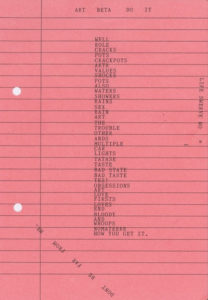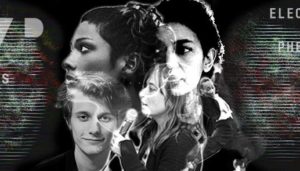
Objects, people and place in Sue Tompkins + Matthew Damhave’s Don’t be far from me at Tenderbooks, Mar 7 – Apr 8





See the EVP website for details.**

Is it stupid to try and achieve the magnum opus of anything? One contemplates this question with the harmony of bodies involved in the third London Contemporary Music Festival (LCMF), running December 11 to December 17, 2015. Buried in London’s post-industrial, subterranean venue, Ambika P3 –home to Sunday Art Fair –the event is an exposition of the past century of sound, presenting about 40 musical pieces, four floors down, under the Westminster Business School. These include work by composers John Cage, Andrew Hamilton and ethiopian nun and pianist Emahoy-Tsegué-Maryam Guèbrou, as well as producers Visionist, Felicita and James Ferraro. It is a divergent spread. They’re clustered into evenings, each with its own thematic title, as listed in a COS clothing brand-sponsored and designed pamphlet.
The evening in December presents three-hours of performances, of which LCMF themes with the title ‘A new definition of Opera II’. The older, more sanctified performances are curated later after the heavily stimulating ones, such as Ryan Trecartin’s ‘CENTER JENNY’(2013) and Jennifer Walshe’s ‘The Total Mountain’ (2014). The penultimate piece is an extract from the lowly ‘La Testament de Villon’ (1926), by poet Ezra Pound. It depicts the soprano –a prostitute –who wavers and wails (kneeling on the ground) as she, ages. Her papier mâché boob is hanging out, and her wig is lopsided. There is humour in the poetry, in the stage, and still her voice is beautiful. Accompanied by a Troubador (a medieval style choir) the concrete of Ambika P3, is filled with this other-worldly sense of the past; a sort of archaic revival occurs.

The pamphlet for LCMF introduces us to the idea of the ‘Gesamtkunstwerk’, Wagner’s proposal for an art of the future; a Utopian construct for a “total / totalising work”. On this particular night of ‘New Opera’, billed in no particular order, all of the works attempt at welding together music with theatre, sound with poetry, or image with sound. What’s interesting, is to think of where this ‘totalising’ effect happens. How far back into the past, or forward in the future has each artist travelled to summon their ‘total’ art? In Pound’s case, a prostitute’s woe met with a medieval chamber choir is totalled attempting a new Vorticist order (a short-lived modernist group that held it that “work must be organic with it’s time”) for opera. In Trecartin’s ‘CENTER JENNY’, humans have evolved from animations and auto-tune is like a fictional botox. Though the Gesamtkunstwerk feels like an old sentiment, it is still occurring. To achieve a total art is probably only possible today by means of the Virtual. To activate narrative into a ‘live’ experience is where it’s going –but the problem is what it is attempting, which is fundamentally totalitarian and weird.
“Give razorblades as a gift!” says a character from Trecartin’s film, suggesting suicide with conviction. The idea is accessorised with a glossy RnB GarageBand snare to accent it as one example in a 50-minute, constant, pulsating soundtrack that includes several, auto-tuned ‘Jenny’s’. I tend to look at others during Trecartin’s screenings, to see how they tolerate it. The frequency and volume of stimulus creates a sort of terminal velocity, a flat dimension. Stopping and thinking is complicated, if not impossible. I like this discord between experience and concept. We are lost in the experience, and the thinking comes after. This is the closest I can imagine being in the ‘vortex’. ‘CENTER JENNY’ is set after what it calls the “second Big Bang”. It makes me think about the future prognosis of the already implied suicide as a right of passage to a tranquil place and the displacement of commodity marked in the gift –a key to getting there. Is Trecartin suggesting the afterlife of suicide is like a silent retreat, a capitalist holiday? Are the razor-blades for cutting against his accelerated version of the contemporary? Pressing eject / drawing blood?

LCMF is a sort of resourceful harmony, an independent triumph. The tasteful shell creates sanctitude for a quite messed up tide of content. The event structure is a feat of curation, enabling a dynamism that crosses all elements; bench seats allow for a turning, straddling, and standing, and people do so as the walls, stairwells, and stages are spotlit accordingly in the massive Marylebone basement-come-art-gallery. Sue Tompkins stands high on a plinth in the spotlight on the opera evening. She’s wearing ripped jeans, with what looks like a borrowed hoodie. She pitches her vocals, screaming “sake!” “marinade!” “vix!”, quoting the Hall & Oates classic with, “she’s a maniaac, maniaac!” in a naïve, rheumatic drill. The performance’s duration is forecast with an hourglass, an effect created as the ‘commercial’ quotes are extracted quote to quote, page to page, beginning to end, from a fat and floppy ring binder on a music stand. The closest it comes to being music is the methodical repetition of it all.
Later in the festival we return to the same stage for the premiere of Walshe’s ‘The Total Mountain’ at the night titled ‘Requiem for Reality’ on December 17. Her Twitter Opera (“hashtag Imagine”) is an exercise in endurance for the artist as well as her audience. As a character within an opera, she plays out the symptoms of the internet institution in presenting tweets like Broadway introductions. Echoed but with more intensity, more reference points, and a consistent level of feminine hysteria, as if Cindy Sherman’s CV was fracked by internet memes and made into a manic theatre production –Walshe’s work displays a similar willingness to act like a sort of possessed clown on stage.

Many of the works at LCMF are perhaps, too loud. Spongy earplugs are provided free at the bar which become a sort of unifying life-jacket in an enduring, one week-long noise festival. Inherent in one evening’s title, ‘5 Ways To Kill Time’ on December 13, we feel the test of the temporal toll in live performance. In each, is a harmony (or discordance) of parts, and the smaller works from earlier on in the festival, and those to come, without distinct operatic tropes are imagined as magnified characters extracted from the opera.
At the ‘A Martian Sends a Postcard Home’ themed night on December 16, for example, Christian Kesten’s ‘Releasing the Tongue’ (1990/99) involves faces doing just that with a baritone and a camera projection of them performing. It is entertaining, clean, but not resonant. I think of them as a layer, a fraction, a mannerism. Underwater, Watson ‘fishes’ for the intimacy of far-reaching, subaqueous sound and disposes of them back into the ambience of the Ambika P3 stage in ‘Okeanos’ (2015). Though impressive, a spaced out intimacy occurs. I mentally describe the sounds into a floatation tank for better effect. Later on, in my mental jacuzzi version of ‘Okeanos’, Hanna Hartman’s ‘Mezcal No.8’ (2014), amplifies contact sounds of air blown through water in glasses. Her circular breathing is impressive, though I notice that both of these works quarrel over abstraction. Yet they’re pinned down to the process and I am very grounded to my clock. Is the ‘purer’ work seeming a bit old fashioned? Or perhaps more like stills / frames impressions within the more fluxus work at large –the world of narrative. I think of the extremes of the new generation of personal computer artists who make emotion synthetic, commodifiable, and no longer palpable, and the loss of the purer sense of tragedy. I wonder how I feel, whether I am sad for this loss. **